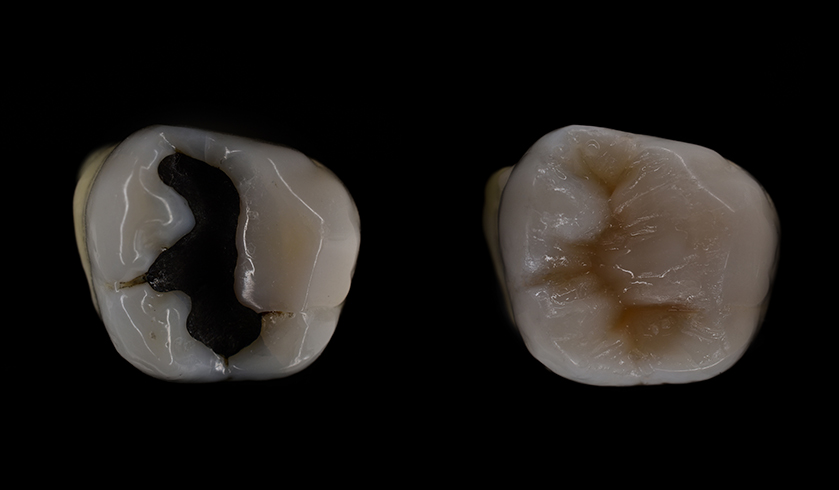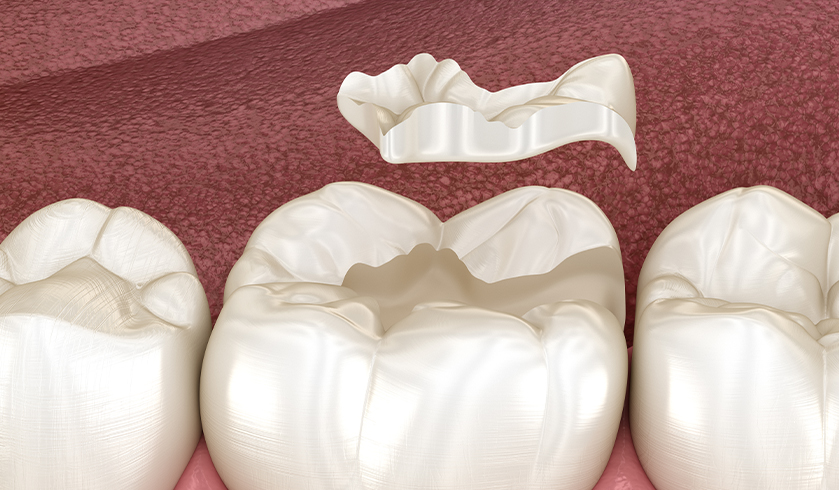Tooth restorations such as dental fillings and crowns can become damaged, loose or fall out when hard or sticky foods are eaten or from prolonged wear. Dental trauma or oral injury may also result in lost dental fillings and crowns.
Although made for durable wear and chewing, teeth restorations are bonded to the teeth with a dental bonding agent, such as dental cement or resin. When the cement or resin becomes worn from daily wear, the restoration may start to loosen and fall out. In some cases, the tooth restoration breaks and requires emergency dental care.
Having regular dental check-ups allows dentists to monitor the condition of tooth restorations, such as fillings and crowns, restoring or replacing them where needed. Just as natural teeth and gums require proper care, so do dental restorations. Dentists provide patients with guidance on how best to care for their fillings and crowns.

Dental Fillings
Dental fillings are used to fill tooth cavities and grooves to restore tooth structure for healthy dental function. Chewing requires strong teeth, so teeth damaged by cavities or fractures are vulnerable to tooth decay, infection, breakage, and loss.
If left untreated, the damaged tooth may fall out or need root canal treatment to prevent infection from spreading through the root canals. Dental fillings seal the tooth and prevent the onset of tooth decay and infection that may cause gum disease and tooth loss.
Dental fillings are made from white composite resin, cement or porcelain. Dental fillings include inlays placed within tooth structures to restore tooth strength. Traditionally, amalgam metal fillings were used, but these are increasingly being replaced by mercury-free white composite or porcelain fillings. Modern dental fillings are tooth-coloured to preserve teeth’ natural colour and shape.
Dental Procedures to Restore Lost Dental Fillings and Crowns
The dental clinician may simply re-bond the crown with dental cement or resin if it has been located and brought to the appointment. However, a new dental crown will need to be custom-made to fit over the damaged tooth if the fallen one is missing.
Where fillings are lost, the clinician will use either white dental composite or dental cement to fill the cavity to seal and reinforce the tooth. A local anaesthetic may be provided while the tooth is prepared for tooth restoration, pain-free filling, and crown care during treatment. Clinicians may use curing lights to speed up the dental bonding and setting process.

Dental crowns, onlays or caps are designed to fit over the tooth cusp to partially or fully restore tooth structure. Teeth may become eroded by foods high in acids or sugar or worn down due to teeth grinding habits. Sports injuries and poor dental hygiene may also damage tooth enamel and tooth cusps.
Existing teeth that require treatment with dental crowns are first cleaned before the dental crown is fixed to restore tooth structure. Tooth restorations are bonded to the existing tooth structure with dental cement or resin to seal the tooth and prevent infection.
If left untreated damaged teeth may develop larger cavities that weaken the tooth structure and expose the inner tooth dentin. Tooth decay and infection may set in, causing tooth sensitivity and pain. The teeth can eventually rot and break or fall out. Emergency dental care may be required to extract a severely infected tooth and be followed by root canal treatment.
Having treatment with dental crowns ensures existing tooth structure is preserved and tooth extraction or loss is prevented. Dental crowns act to reinforce tooth structure and are also used to fill tooth gaps for straighter teeth.
Dental crowns enable healthy bite function and improve aesthetics for a fresh, bright smile. Where patients have lost teeth, dental implants may be inserted as replacement tooth roots to anchor a dental crown. Alternatively, dental crowns may be used to anchor dental bridges that serve as a replacement for missing teeth.
Losing a dental filling or crown is not an unpleasant experience, and individuals may only become aware of the situation when tooth sensitivity develops from exposed tooth dentin. However, in cases where oral trauma is present with lost dental fillings and crowns, discomfort may be experienced.
While some are lucky enough to take a crown out of their mouth that has fallen from the tooth structure, others lose crowns without even noticing the event. Fillings can dislodge when chewing food.
If the condition is left untreated dental decay or infection may set in, causing further tooth sensitivity and pain. Seeking treatment as early as possible is recommended to prevent bacterial development at the tooth site where the filling or crown is lost. Emergency dentists are on hand to provide treatment to restore damaged or lost dental fillings and crowns.
Firstly, try to find and keep the filling or crown that has fallen out and take it with you to the dental appointment. Contact a dentist or emergency dentist immediately when you have recognised a loss of tooth restoration, such as a filling or crown.
The crown may be re-bonded in some cases but will need replacement if lost. Fillings generally need to be replaced once lost to restore the tooth back to correct health and function. Although temporary dental kits can be used for short-term treatment until professional dental care is received, they are not a permanent solution to lost dental fillings and crowns.
Dental restorations, such as fillings and crowns, have a life expectancy of around ten years, depending on the material used to create the restoration. New materials and technology are in development to improve dental restoration choices for patients.
Following dentist guidelines for tooth restoration is essential. It should include careful flossing and avoidance of sticky foods that may pull out the filling, as well as continued regular dental hygiene to keep bacteria at bay.
Dental check-ups enable restorations to be monitored and restored as needed. Accessing emergency dental treatment when oral trauma occurs or when a dental restoration is damaged, broken or lost is highly important. This allows early intervention so restorations may be restored or replaced for healthy dental function. Keeping dental appointments for fitting and maintaining dental restorations is vital to preserving existing tooth structures.
Get started with a dental consultation
If you have lost dental fillings and crowns don’t hesitate to contact us. Get in touch by phone or email, and a member of our friendly team will book an appointment for an oral health evaluation.
Get in touch